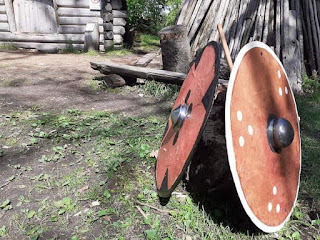The Spear Dance
Reimagining Prehistoric Dance and Experience
To do the prehistoric “Spear dance” dance works, I read studies about the actual iconography and about the symbolism of the viking age. I am also a huge lover of Finnish and Nordic mythology and that has hugely influenced my performance.
About the weapon dancer: https://bornholmarch.eu/wp-content/uploads/2020/04/A_storm_of_swords_and_spears_The_weapon.pdf
About the symbolism by the incredible Tomáš Vlasatý:
https://sagy.vikingove.cz/en/friendship-with-the-god
On this blog we have been mostly talking about recreating prehistoric fighting, but the interest of the group is much larger. In my (Arttu) work I have tried the same methods to recreating prehistoric fighting by creating an interpretation of prehistoric dance. I have done 4 different performances on this subject. The first one was a solo dance where I improvised a set of material that imitated dancing in the stone age rock art. It was considered quite a success. I reprised the work as a bigger piece to which I hired another dancer and a musician who was also a practicing shaman. With them we added a ritualistic structure to our play.
Like I mentioned, the performance was a huge success, but unfortunately it was too expensive to perform. This means it had a very short life on stage. Inspired by its success, I started to work on a new piece. “The spear dancer”.
The method for the first piece was the following: I went through all images of stone age rock art I could find that depicted dance like movement. This was a huge amount of work, but from it I collected a few examples that showed a posture that had been painted all over the planet. I did not want to use something that was only done for example in Africa, but I wanted to use both Finnish and universal pictures. There were 10+ positions that were painted all over the world, that I should interpret as universal human movement. Movement style of the species if you will. Some themes also appeared in every continent. For example human animal hybrids, especially human-as-bird hybrids were a common theme. Then the process continued seeing this movement as it is done in contemporary folk/tribal dances all over the world. Often the movement was structurally similar, but rhythmically different as the music styles were not the same.
An example of dance poses that can be seen as similar.
For the spear dancer I collected a set of pictures that I liked most from the Nordic countries, mostly from Norway. I kept a few rock paintings from the area of Finland in the set, like the two horned shaman from “Hossa värikallio”. I also studied a lot of Asian and African sources, but decided to keep the material on the Germanic spear dancer iconography. Some of the best weapon dancer pictures are from Vendel era helmets, and those often show a dancer wielding 2 spears. I did my first version of the spear dancer using only one spear like is common in Norwegian rock carvings, and thus the actual movement in the dance did not benefit much from those. The animal hybrids were still present in this iconography so I kept the idea of changing into an animal during the performance.
The shamanistic experience is not so commonly talked about in the small amount of literature I read about the weapon dancer. Then again, the later icons of the dancer are commonly seen as Wotan/Odin and thus the dancer can be seen as the original shaman climbing up and down the Yggdrasil and being the speller of mead of poetry. For the fun of it, I kept the shamanistic trance traveling as part of my performance. I also portrayed a bird in my movement, as Odin is known to spill the mead in his bird form. This is completely artistic and I do not think this could be read from the iconography, as the meaning of the weapon dance is a mystery due to its prehistoric nature. (Nevertheless, the personal interpretation of the artist in a deep-dive like this is always a relevant interpretation. – Ed.)
I started my performance by climbing up a tree where the spear was waiting for me, I ended the performance by throwing my spear to that tree. I was successful in building a trigger in myself that activated a trance state as I threw my spear. My method of being in trance was originally trained in stone age style performance and used a TRE style method (https://traumaprevention.com/) combined with heavy breathing and voice/movement practice. As I ended the performance I (and my shaman Keke Lammassaari) came out of the trance and did a calming down breathing and laughing until we could no longer.
As both the audiences and academics loved our performance, it has been performed 12 times already in Finland in museums and dance festivals. The methods I used we copied from the process of rediscovering prehistoric fighting. My later work on stone age dance was even more praised, and commented by the Finnish National Broadcasting Company YLE, and I have had the pleasure to talk about it in an archaeology and art themed seminar in the University of Turku.
Read the news article here:
As this has hugely influenced my professional life and keeps on employing me, I wish to say huge thanks to the re-enactment community and the Hirdmenn team for helping me to learn how to reimagine prehistory. Big shout outs especially to Roland Warzecha aka the Dimicator, and Joeli Takala, for I experience you as my teachers, but also to the whole community.


Comments
Post a Comment